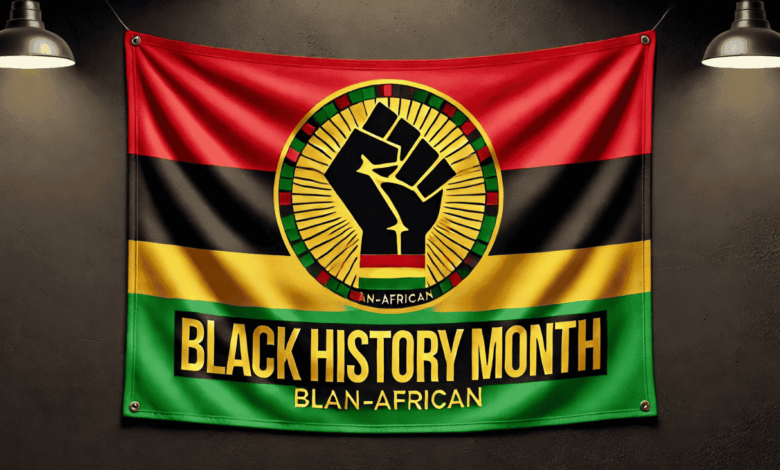Black History Month Flag: A Symbol of Unity, Resistance, and Celebration

Black History Month, observed every February, is a time to reflect on the history, struggles, achievements, and contributions of Black people worldwide. While the month is celebrated through various events, educational programs, and community gatherings, a prominent symbol of this celebration is the “Black History Month flag.” This flag represents more than just a commemoration of Black history—it embodies the ongoing fight for racial equality, justice, and unity across the globe.
The Significance of the Black History Month Flag
The concept of a “Black History Month flag” has evolved to encompass a wide range of meanings. Several flags and banners are used to symbolize the unity and heritage of Black communities during Black History Month. While there isn’t a universally recognized “Black History Month flag” that officially flies during the month-long observance, a number of flags used within the larger Black liberation and civil rights movements resonate deeply during this time.
Among the most iconic flags associated with Black History Month is the Pan-African flag. Designed by Marcus Garvey in the 1920s, this flag uses three horizontal stripes—red, black, and green—to represent the blood shed for freedom, the people of African descent, and the land of Africa, respectively. This flag has become a powerful symbol for the African diaspora, representing both pride and resilience. During Black History Month, the Pan-African flag is often seen in celebrations, protests, and events that honor Black history.
The Black Lives Matter Flag: A Modern Emblem
In recent years, the Black Lives Matter (BLM) flag has emerged as another prominent symbol during Black History Month. Though not initially associated with the history month itself, the Black Lives Matter movement has gained global recognition for its advocacy for racial justice and equality. The BLM flag, with its bold, direct message, serves as a reminder that the fight for Black rights is far from over. This flag, often seen in protests and rallies, represents the continued fight for justice and equality for Black people, specifically highlighting issues such as police brutality, systemic racism, and economic inequality.
African American Heritage Flags
In addition to the Pan-African flag, there are various flags that specifically celebrate African American heritage. One notable example is the African American Heritage Flag, which was designed to honor the struggles, contributions, and history of Black Americans. The flag features colors that represent the culture and spirit of the African American community, often incorporating symbols like the raised fist—an iconic gesture of resistance and solidarity.
These flags are used in schools, museums, and community centers during Black History Month to remind people of the importance of understanding and celebrating African American culture and history. The African American Heritage Flag, along with the Pan-African flag, acts as a powerful visual symbol of the richness of Black history, not just in the United States, but globally.
Why the Flag Matters: A Reflection of Struggle and Progress
The significance of the “Black History Month flag” extends beyond its colors and design. It’s a visual representation of the complex history of Black people and their ongoing struggle for recognition and equality. Each flag, whether it’s the Pan-African flag or the Black Lives Matter flag, holds deep meaning rooted in the collective experiences of Black communities around the world.
For generations, Black people have fought against oppression, discrimination, and violence. Flags have historically been used as symbols of resistance, rallying points for those fighting for freedom. The flags associated with Black History Month carry that same weight of history. They remind us of the painful past and the progress that’s been made, but also of the work that still needs to be done.
Celebrating Black Heritage Through Flags
During Black History Month, flags such as the Pan-African flag and the African American Heritage Flag are proudly displayed to honor the cultural achievements of Black people. The “Black History Month flag” can be seen in schools, government buildings, and at community events, where they serve as a visual reminder of the importance of celebrating Black history year-round. These flags provide a sense of pride and unity for the Black community, reinforcing the message that Black history is American history—and, indeed, world history.
By proudly displaying these flags, we not only celebrate Black culture but also reaffirm our commitment to equality, justice, and progress. Black History Month, while dedicated to reflecting on the past, also encourages us to continue to advocate for change. These flags symbolize that change, a beacon of hope and determination for a brighter future.
The Role of the Black History Month Flag in Social Movements
In the context of social movements, flags often serve as unifying symbols for collective action. The Black History Month flag can be seen at protests and rallies, where it acts as a rallying cry for solidarity among Black people and their allies. Whether at local events, national celebrations, or international movements, the display of these flags creates a shared identity and common purpose.
For example, during the global protests following the death of George Floyd, the BLM flag became a prominent symbol of resistance. It was carried by protestors around the world, serving not only as a symbol of mourning but also as a declaration of the urgent need for change. This flag continues to be a symbol of the commitment to Black liberation and justice, both during Black History Month and throughout the year.
Conclusion: A Powerful Symbol of Resilience and Hope
The “Black History Month flag” serves as a powerful emblem of unity, resistance, and celebration. It is not just a decorative piece but a visual representation of the ongoing struggle for racial justice, equality, and the recognition of Black history and culture. Whether it’s the Pan-African flag, the Black Lives Matter flag, or the African American Heritage Flag, these symbols serve as reminders of the past, present, and future of Black history. As we continue to honor and celebrate the achievements of Black people during Black History Month, the flags we display remind us of the resilience and strength of the Black community and the continued work toward a more just and equal world.



